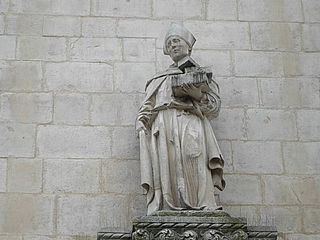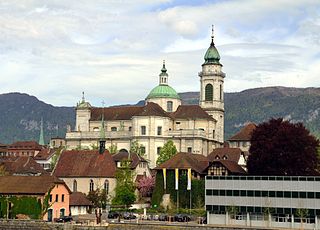
Aosta is the principal city of the Aosta Valley, a bilingual region in the Italian Alps, 110 km (68 mi) north-northwest of Turin. It is situated near the Italian entrance of the Mont Blanc Tunnel, at the confluence of the Buthier and the Dora Baltea, and at the junction of the Great and Little St Bernard Pass routes.
Ursus is Latin for bear. It may also refer to:

The Basilica of Sant' Apollinare in Classe is a church in Classe, Ravenna, Italy, consecrated on 9 May 549 by the bishop Maximian and dedicated to Saint Apollinaris, the first bishop of Ravenna and Classe.
Alban of Mainz was a Catholic priest, missionary, and martyr in the Late Roman Empire. He is venerated as Saint Alban of Mainz in the Catholic Church, not to be confused with Saint Alban of Verulamium.
Saint Juventius, sometimes spelled Eventius, Iventius, or Inventius, was a bishop of Pavia during the 4th century, holding the position for 39 years. Together with Syrus of Pavia, he was sent to Pavia by Saint Hermagoras to evangelize the city, founding a bishopric there. Syrus subsequently served as first bishop of Pavia.

Gratus of Aosta was a bishop of Aosta and is the city's patron saint.

The Collegiate church of Saint Ursus is a collegiate church in Aosta, northern Italy, dedicated to Saint Ursus of Aosta.
Boniface of Valperga, venerated as a blessed in the Catholic Church, was a thirteenth-century Bishop of Aosta.
Émeric de Quart, born in the latter part of the 13th century at the castle of Quart in the Aosta Valley, was Bishop of Aosta from 1302 until his death on 1 September 1313. He is more frequently named in ancient documents as Eymericus than Emericus or even Aimericus.
Eleuchadius is a 2nd-century Christian saint venerated by the Roman Catholic and Eastern Orthodox Churches. He served as the third bishop of Ravenna from 100 to 112.
Theonistus is a saint venerated by the Catholic Church. Theonistus is venerated with two companions, Tabra and Tabratha. Medieval documents give accounts of his life, which are contradictory and confusing.
Adheritus was Bishop of Ravenna during the 2nd-century and successor to Saint Apollinaris, the first bishop of Ravenna. He was of Greek origin and was a follower of Apollinaris Adheritus died on 27 September at the port of Classe, and his remains are venerated in the Basilica of Sant'Apollinare in Classe near Ravenna, Italy
Anastasius of Pavia was Bishop of Pavia (Ticinum) from 668 until his death in 680. He was a convert from Arianism. He was succeeded by Damian of Pavia.
Crispin of Pavia was Bishop of Pavia in the 5th century during the reign of Pope Leo I. He was among the 20 bishops from Northern Italy who attended the Synod of Milan in 451.

Pamphilus of Sulmona was bishop of Sulmona and Corfinio (Valva) during the late 7th century. He is revered as a saint by the Roman Catholic Church and the Eastern Orthodox Church.

The St. Ursus Cathedral or Solothurn Cathedral is the cathedral of the Roman Catholic Diocese of Basel in the city of Solothurn, Switzerland. It is a Swiss heritage site of national significance.

Ravenna Cathedral or Metropolitan Cathedral of the Resurrection of Our Lord Jesus Christ is a Roman Catholic cathedral dedicated to the Resurrection of Jesus Christ in the city of Ravenna, Italy. Formerly the archiepiscopal seat of the Archdiocese of Ravenna, it is now the seat of the archbishops of Ravenna-Cervia.

Christianization of the Franks was the process of converting the pagan Franks to Catholicism during the late 5th century and early 6th century. It was started by Clovis I, regulus of Tournai, with the insistence of his wife, Clotilde and Saint Remigius, the bishop of Reims.

Ursus was bishop of Ravenna during the late 4th century.

Ecclesius was bishop of Ravenna from AD 521 to 532. He is best known as the founder of the Basilica of San Vitale in Ravenna.










